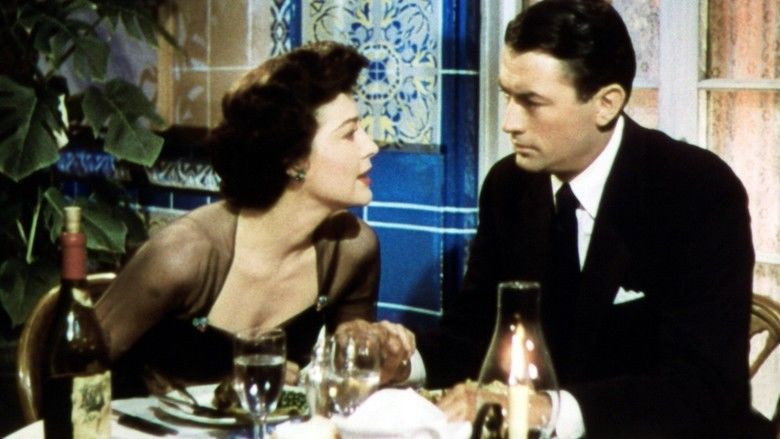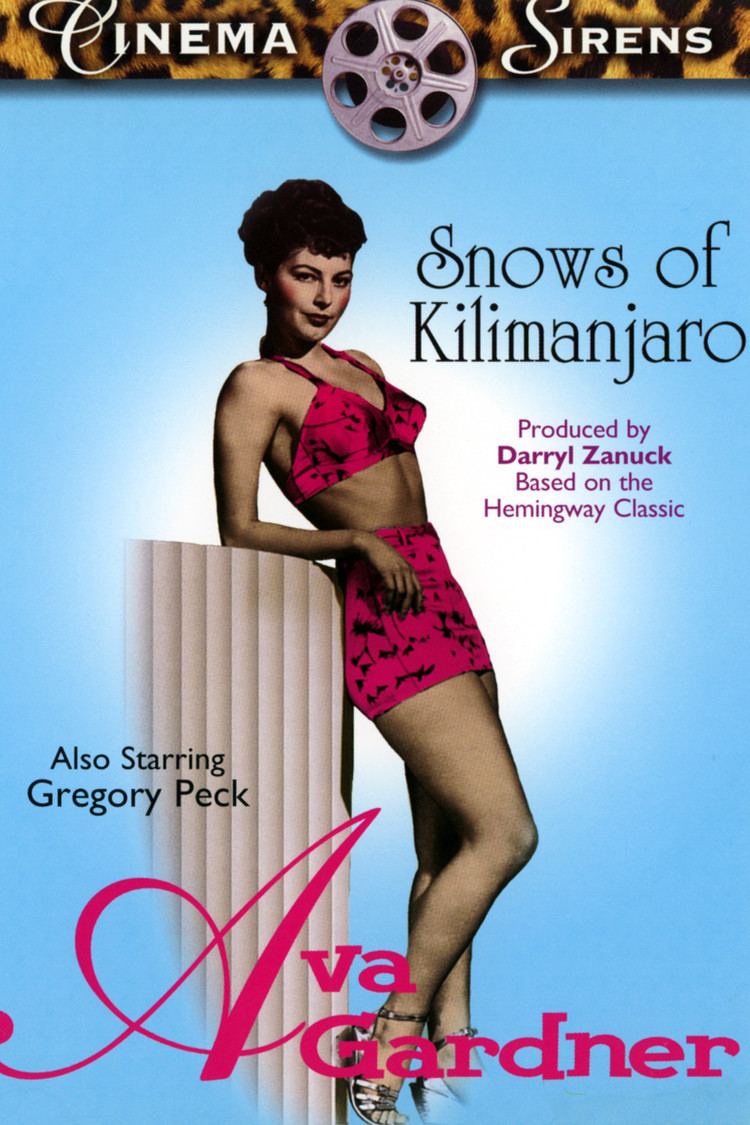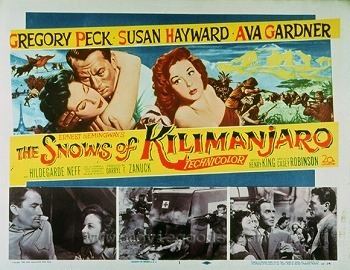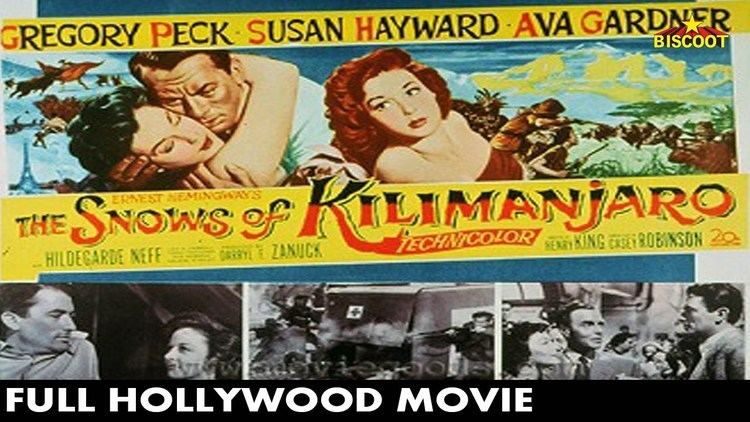The Snows of Kilimanjaro (1952 film)
6.2 /10 1 Votes
Initial DVD release March 6, 2007 Country United States | 6.2/10 IMDb Genre Adventure, Drama, Romance Duration Language English | |||||||||||||||||||||||||||||||||
 | ||||||||||||||||||||||||||||||||||
Release date August 18, 1952 (1952-08-18) Cast (Harry Street), (Helen), (Cynthia Green), (Countess Liz), (Onkel Bill Swift), (Johnson) Similar movies Madagascar: Escape 2 Africa , Out of Africa , The Lion King 1½ , Romancing the Stone , The Naked Prey , The Lion King 2: Simba's Pride Tagline His Adventures . . . Like His Loves . . . Were Great and Exciting ! | ||||||||||||||||||||||||||||||||||
The snows of kilimanjaro 1952 gregory peck hd
The Snows of Kilimanjaro is a 1952 American Technicolor film based on the short story of the same name by Ernest Hemingway. The film version of the short story was directed by Henry King, written by Casey Robinson, and starred Gregory Peck as Harry, Susan Hayward as Helen, and Ava Gardner as Cynthia Green (a character invented for the film). The film's ending does not mirror the book's ending.
Contents
- The snows of kilimanjaro 1952 gregory peck hd
- Plot
- Cast
- Production
- Casting
- Filming
- Reception
- Home media
- References

Considered by Hemingway to be one of his finest stories, "The Snows of Kilimanjaro" was first published in Esquire magazine in 1936 and then republished in The Fifth Column and the First Forty-Nine Stories (1938).

The film was nominated for two Oscars at the 25th Academy Awards, for Best Cinematography, Color and Best Art Direction, Color (Lyle R. Wheeler, John DeCuir, Thomas Little, Paul S. Fox).

The film has entered the public domain.

Plot

The film begins with the opening words of Hemingway's story: "Kilimanjaro is a snow-covered mountain 19,710 feet high, and is said to be the highest mountain in Africa. Its western summit is called the Masai 'Ngje Ngi,' the House of God. Close to the western summit there is the dried and frozen carcass of a leopard. No one has explained what the leopard was seeking at that altitude."
The story centers on the memories of disillusioned writer Harry Street (Gregory Peck) who is on safari in Africa. He has a severely infected wound from a thorn prick, and lies outside his tent awaiting a slow death, though in the film it is pointed out he may have acquired the infection from leaping into a muddy river to rescue one of the safari's porters from a hippo after he falls in the river. His female companion Helen (Susan Hayward) nurses Harry and hunts game for the larder.

The loss of mobility brings self-reflection. In an often delirious state he remembers his past relationship with Cynthia (Ava Gardner) whom he met in Paris as members of the "Lost Generation". Upon the sale of Harry's first novel, rather than rent a nicer home, Harry wishes to go on safari to Africa. There he has his happiest moments; Harry bags a rhino whilst Cynthia becomes pregnant. Upon their return to Paris, Cynthia's love for Harry and her desire not to impede the excitement-addicted Harry's travels as a successful journalist and author lead her to bring about a miscarriage so their child won't slow down Harry's career. Suffering depression and sinking into alcoholism. she eventually leaves Harry for a flamenco dancer when she believes Harry is off for a job as a war correspondent.
Harry later becomes engaged to the wealthy and socially connected Countess Elizabeth (Hildegard Knef) whom he meets on the Cote d'Azur; however, he still remains loyal to the memory of Cynthia. On the eve of their wedding a drunken Elizabeth confronts Harry with a letter to Harry sent from Cynthia now in Madrid. Elizabeth destroys the letter in front of Harry who stalks off to go to Spain. Unable to find Cynthia at the Madrid address on the envelope, he enlists to fight in the Spanish Civil War. During a battle he meets Cynthia who is now an ambulance driver. Cynthia is mortally wounded and Harry is shot and wounded when he deserts the battle to try and bring the dying Cynthia to a doctor.
Harry returns to Paris. While he is standing on the bridge watching the river, he meets Helen who reminds him of Cynthia. After the death of his beloved mentor Uncle Bill (Leo G. Carroll), Harry receives as a bequest a letter from his uncle that gives him the riddle of the leopard. Harry's bartender suggests that the leopard ended up there as he was on a false scent and became lost, but Harry takes Helen on a safari to Kenya to learn the answer of the riddle. He is injured and develops an infection. As Harry nears death, the protective Helen fights off a witch doctor and by reading an emergency first aid manual, opens Harry's wound to release the infection. At the dawn a medical party arrives by airplane. The vultures and hyena who have been awaiting Harry's death leave and never return. Harry realises his love for Helen.
Cast
Production
Twentieth Century-Fox bought the rights to the story in June 1948, paying $125,000.
Casting
Humphrey Bogart, Richard Conte and Marlon Brando were all reported to be under consideration for the male lead, as was Dale Robertson.
Filming
The film was shot on location in Nairobi, Kenya, Cairo, Egypt, the French Riviera, and studio work was done at Stage 14 in 20th Century Fox Studios. During production, on April 8, 1952, when Peck was carrying Gardner for a scene in the film, Peck wrenched his knee and production had to be postponed for 10 days while he recovered in his Pacific Palisades home, and Hildegard Knef came down with influenza in the studios. She was able though to sing two Cole Porter tunes in the film. Jazz musician Benny Carter performs early on in the film.
The bullfight sequences were archive footage, taken from Fox's 1941 film Blood and Sand.
Reception
Helped by a star-studded cast, the film was one of the most successful films of the early 1950s and earned $12.5 million at the box office, very high for that period. The film was nominated for two Academy Awards; for Best Cinematography and Best Art Direction (Lyle R. Wheeler, John DeCuir, Thomas Little, Paul S. Fox). The film was much acclaimed by critics, although some vary in their opinion of it, ranging from "simply plodding" to "much-maligned". The cinematography was highly acclaimed in particular, and even the sophisticated interiors were praised. Bosley Crowther of The New York Times described the cinematography as "magnificent and exciting" and said that the "overall production in wonderful color is full of brilliant detail and surprise and the mood of nostalgia and wistful sadness that is built up in the story has its spell." He praised Peck's character for his "burning temper and melancholy moods", although he said that Ava Gardner was "pliant and impulsive" in a role "as soggy and ambiguous as any in the film". Bowker's Directory described it as having "plenty of action & romance" and stated that it was "the popular 'celebrity film' of its time". Hemingway, who disliked the typical Hollywood happy ending, accepted the money for the film, but he could not bring himself to view the film, according to one report. However, in a 1954 article for Look magazine, Hemingway said a hyena was the best performer in the picture, which the writer called The Snows of Zanuck.
Home media
20th Century Fox released the film on DVD in March 2007, separately and as part of five-disc collection entitled "The Ernest Hemingway Film Collection", where it was packaged with Under My Skin, The Sun Also Rises, A Farewell to Arms, and Hemingway's Adventures of a Young Man.
References
The Snows of Kilimanjaro (1952 film) WikipediaThe Snows of Kilimanjaro (1952 film) IMDb The Snows of Kilimanjaro (1952 film) themoviedb.org
